Bridgestone RE-71r Head To Head Comparisons
Published: December 8, 2017; updated: January 30, 2018
This page contains specific comparisons between RE-71r and other tires broken out of the main review to keep the size of the main review manageable.
NJMP Thunderbolt - Vs RA-1, RR, Star Specs
I've run several different tires in the same day with the car being configured identically and track conditions also being roughly the same:
- Full tread 205/50-15 RA-1 - best lap time 1:40.5
- Old 225/45-15 Toyo RR front with a large number of heat cycles & not quite as old 205/50-15 Nitto NT-1 rear - best lap time 1:39.5
- New RE-71r - best lap time 1:39.5 (before rear toe change)
- New RE-71r - best lap time 1:38.5 after rear toe change
The first three results were with the car identically configured. The fact that RE-71r posted a lap time a second under full tread RA-1 is impressive; while I have read that RE-71r is as fast as RA-1/NT01/R888 I did not really believe that until this test. Clocks don't lie though as Emilio Cervantes would frequently tell me.
The last two results represent the difference in performance as a result of setting up the car better once on RE-71r.
Speed trace of full tread 205/5-15 RA-1 vs 205/50-15 RE-71r with the same car setup vs 205/50-15 RE-71r with zero rear toe:
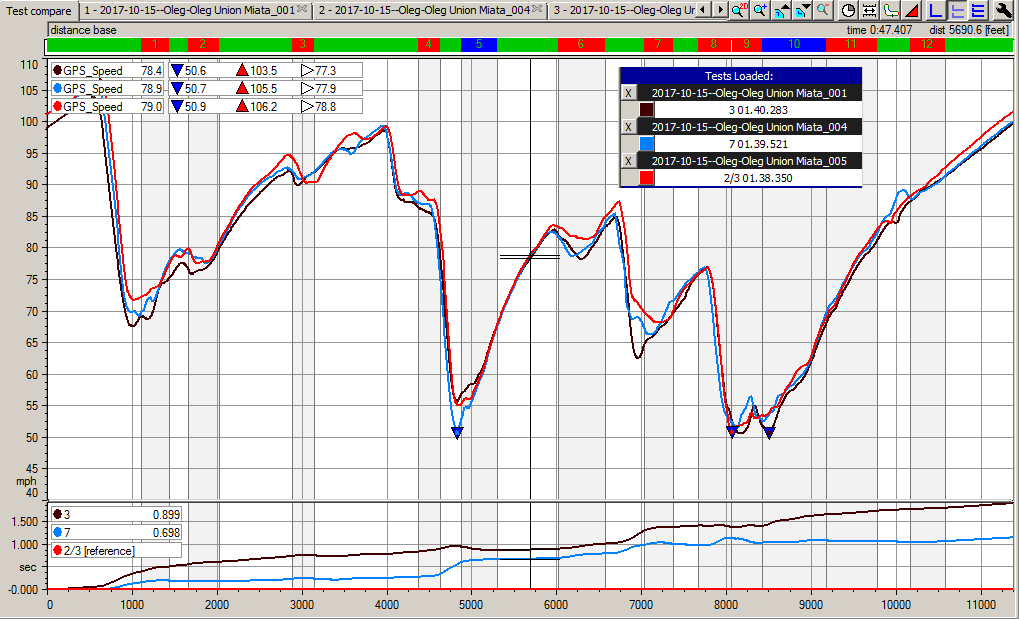
Looking at the black line (RA-1) and the blue line (RE-71r with the same setup), the tires are pretty close throughout the lap. There are some differences in turns 5 and 7 but they look like they have more to do with the driver than with the tires. Of note are turn 1 and Octopus and to a lesser extent turn 2 - RE-71r are carrying slightly more speed through and out of the corner, and this is where they gain the half a second lap time delta for the most part.
The red line vs the blue line illustrates setup effects on RE-71r. On the blue line the car experienced noticeable understeer in several corners like turn 7 and Octopus which limited corner speeds. On the red line the car was almost perfectly balanced and more tossable, the result of which were higher cornering speeds leading to higher exit speeds, resulting in consistent gains in lap time throughout the lap.
Here is another comparison of the best lap on new 205/50-15 RE-71r (that's with zero rear toe, red) vs decently worn but decent 205/50-15 Dunlop Star Specs ZII (black) vs well worn and well heat cycled 205/50-15 Toyo RR (blue):
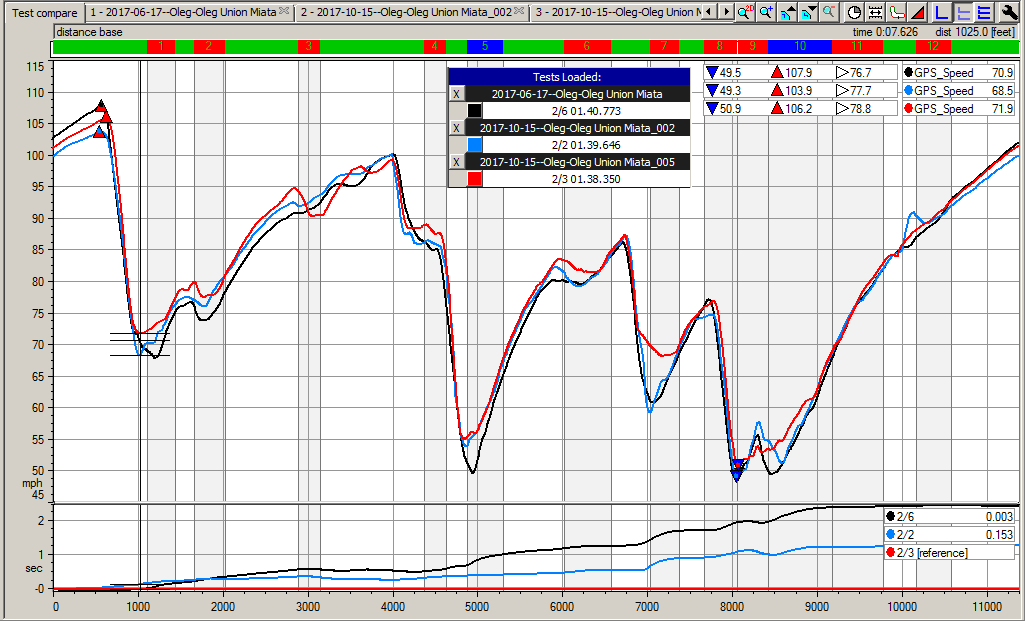
This is not a terribly accurate comparison in that the Star Specs and RR were on the car prior to the Torsen, NB top hats, FCM bump stops, lower ride height and more camber. Also, both Star Specs and RR were well worn by the time I got the respective sets of tires. I will update this review once I wear RE-71r down some to be more in line with the state of these sets of tires.
Intesting aspects of this comparison are:
- RE-71r are significantly faster through turn 1 due to a much earlier throttle application point. This is a result of both car setup (Torsen, shock travel, camber) and tires.
- RE-71r are also faster through turn 2. This is probably primarily a result of the improved suspension on the car between the events (NB top hats, FCM bump stops, more shock travel, more camber, lower ride height).
- RE-71r are again beating the other tires in turn 4, which is all about grip and stability. Car setup is extremely important for turn 4 but the tires need to hold the car to the pavement - setup alone is insufficient.
- Turn 7 again demonstrates superior overall grip, stability and tossability of the car on RE-71rs with suspension changes. Unfortunately there is no way to break the differences into those attributable to the tires vs car setup given the data I have to date.
- RE-71r match worn RR in turn 5 and Octopus - low speed corners which are more reliant on tire grip than car setup. Despite RR being old in the test, the result is significant because in a DE setting most of the time spent driving on R compound tires is when the tires are in the middle of their life rather than when they are fresh. If RE-71r can maintain their maximum grip over heat cycles better than R compound tires do, the effect would be that RE-71r would be pretty close to the actual performance of, say, RR in a DE environment.
- Star Specs give up time in turn 5 and Octopus - same corners we just discussed. This suggests Star Specs have a comparatively lower grip, though Star Specs were used by the time I tested them whereas RE-71r were brand new.
Mid-Ohio - Vs Star Specs, RS3
I've tested RE-71r and Star Specs ZII/Hankook RS3 on the same day with identical car configuration. Due to competition rules constraints I was unable to also test Toyo RR on the same day.
I've done a best of 1:49.2 at Mid-Ohio with 205/50-15 RE-71r, driving at about 9/10ths. I refrained from sliding and plowing the car unnecessarily but opted for good exits out of turns 2 and 6. I ran several laps in the 1:49 range, but never hit 1:48. The car could certainly hit 1:48 but not in a sustainable endurance racing pace - a 1:48 effort is hero lap territory, overheating the tires to the point of the car not being able to run that pace for more than a couple of laps.
With 205/50-15 Star Spec ZII on the front and 225/45-15 Hankook RS3 on the rear of the car with everything else being the same, I ran multiple laps at 1:48.5 pace. I pushed Star Specs/Hankooks harder - at 9.5/10ths I would say - and they were louder when I drove, however as far as I can tell they wore less than Bridgestones, and they did not overheat, which means in an endurance racing scenario the driving level was comparable with 9/10ths driving on RE-71r.
RE-71r are brown, 205/50-15 Star Specs front / 225/45-15 RS3 rear are green:
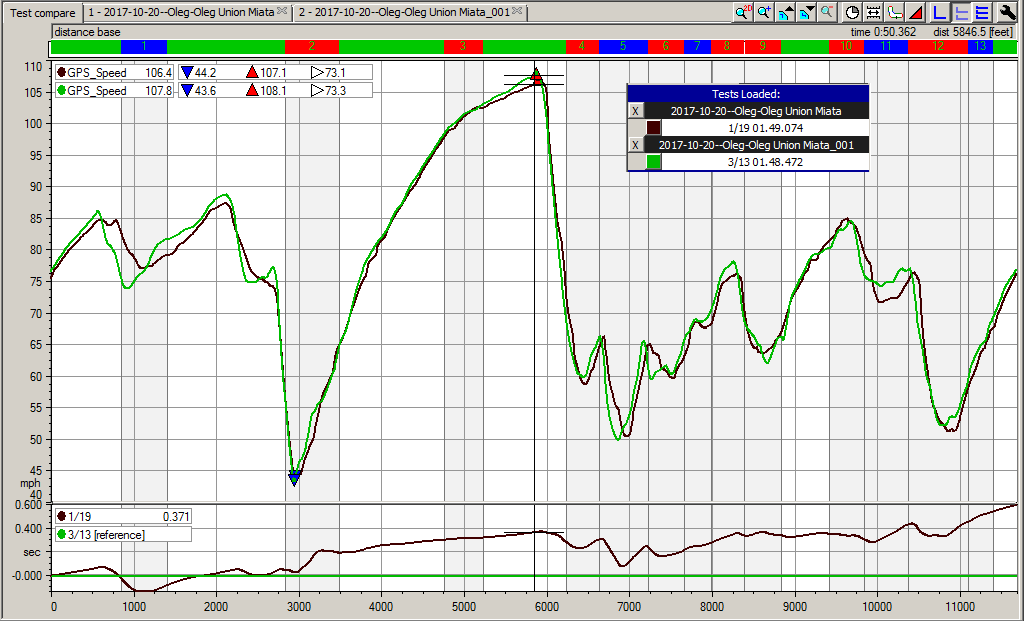
Bridgestones are able to enter turn 1 much faster but lose on the straight - a phenomenon I witnessed later at Summit Point. Bridgestones are able to attain a faster entry into the keyhole than Star Specs/RS3; if I wanted to slide the car more I believe Bridgestones could be even faster, at the expense of even higher wear. Once on the back straight Bridgestones again seem to be gaining speed slower, especially on the top end. The tires are surprisingly even between Madness and Thunder valley which I attribute again to some measure of conservation when running the Bridgestones and full attack mode on Star Specs/RS3. Carousel indicates a significantly lower cornering speed for RE-71r which again is primarily driven by the desire to not burn the tires off the wheels in one session.
The similarity of minimum corner speeds between practically new Bridgestones and almost heat cycled out Star Specs/RS3 indicates that the track can be just as big of a factor in overall performance of the car as tires.
Summit Point Main, Repaved - Vs NT01, RA-1
I've tested RE-71r against a mixed 205/50-15 NT01 front / 225/50-15 RA-1 rear setup on the freshly repaved Summit Point Main course in November 2017. The event ran in very cold temperatures - freezing overnight and 35-45°F during the day. The set of RE-71r at this point has accumulated about 2 track hours between Thunderbolt and Mid-Ohio events. NT01 and RA-1 tires were old and almost at zero tread depth - the right front NT01 actually started out with cords showing.
The car was a 2003 Miata with Flyin' Miata springs, Tokico one way adjustable shocks, FM sway bars, 5 speed, 4.3 Torsen diff, at 2480-2530 lbs competition weight.
I ran Bridgestones on Saturday to a best lap of 1:29.6. I reached that pace in the first timed time trial session and ran it the entire day. I imagine the car could sustain it indefinitely.
There was not a lot of tire sliding going on, as it is usually unnecessary and counterproductive at Summit Point. However, since Summit Point Main is primarily a right turn track, the left front tire accumulates most of the wear, especially on its outside edge.
On Sunday I ran the 205 NT01 front / 225 RA-1 rear combo in very similar conditions - it was a couple of degrees warmer in the afternoon but still very cold. In the very first non-timed session I ran a 1:28.7 on the R compounds. Subjectively I was able to brake deeper into turns 1 and 5 which are the heavy braking zones at Summit Main. Coming out of turn 5 the car experienced significant understeer due to corded outside edge of the right front tire. Elsewhere no the lap the car drove very similar between Bridgestones and Nittos/Toyos.
Brown is RE-71r, green is NT01/RA-1 combo:
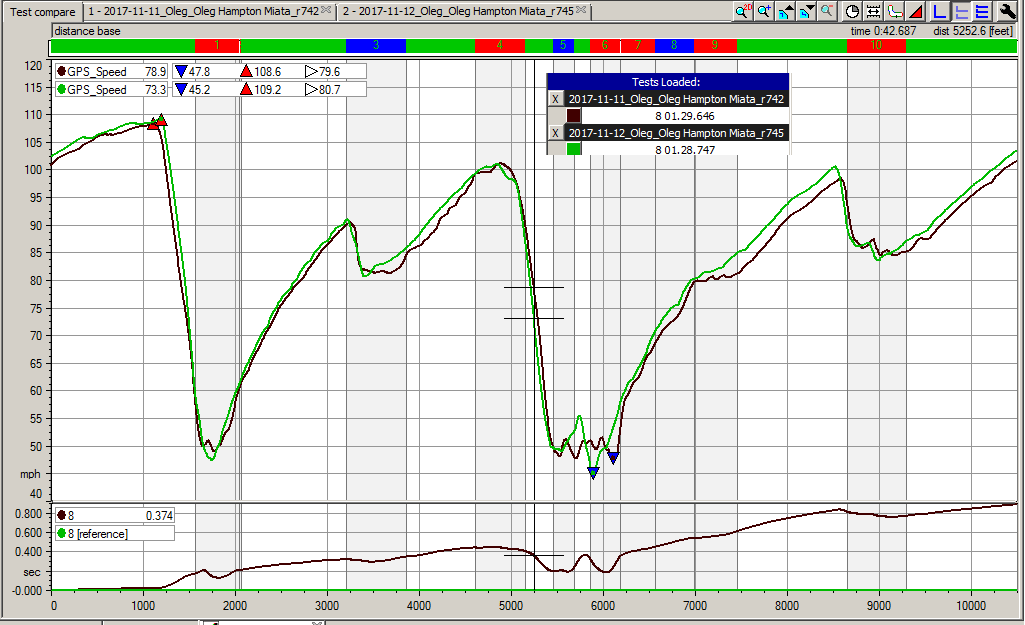
The difference in braking for turn 1 is easily visible. On R compounds I start braking later at a higher speed and match the speed of RE-71r at the end of the braking zone.
The other interesting difference is in turn 3, 6 and 10 corner exits. Looking at the graphs alone the most logical conclusion is earlier throttle application in all of those corners, however I am pretty sure this is not the case. Additionally the 225/50-15 RA-1 rears are taller than the 205/50-15 Bridgestones meaning the car loses gearing thus effective power, yet somehow accelerates equally hard. My explanation is the RE-71r lose more speed due to scrub in the corners, especially the high speed ones.
National Corvette Museum Motorsports Park - Vs Star Specs + RS3, R888R
The next test was at NCM Motorsports park back in the 1990 Spec Miata. The weather was dry but cold, with ambient temperature in the 50-60°F range.
I first compared RE-71r, now at about half tread and flipped inside out (red), to my set of "dead" 205/50-15 Star Specs on the front and more dead 225/45-15 Hankook RS3 in the rear (black):
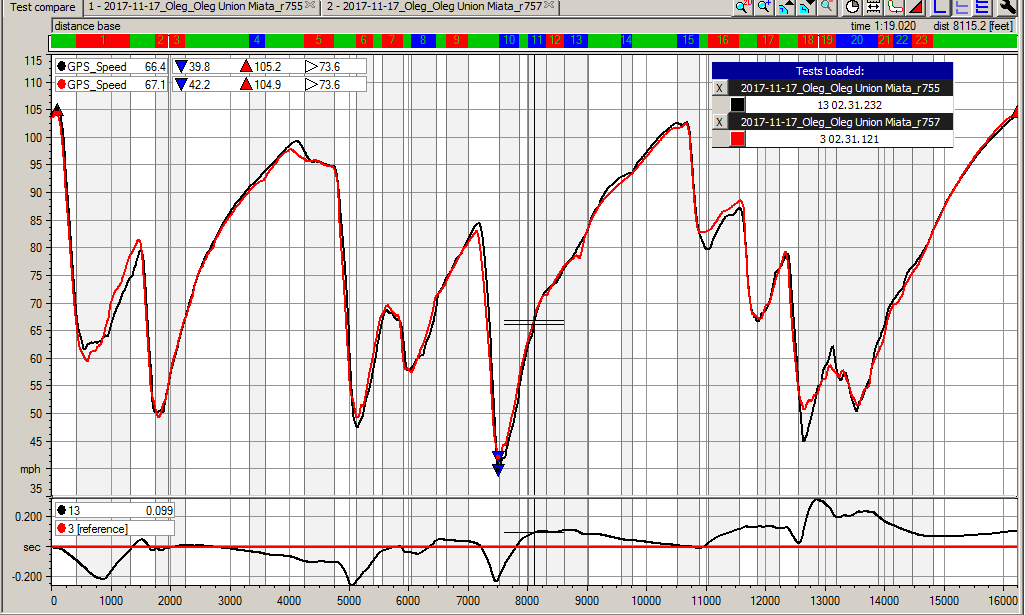
While the tires feel differently, it is amazing that they not only run virtually an identical lap time but actually match one another's track position at mutiple points throughout the lap. Now, the Bridgestones - having a rather low number of heat cycles on them still - are much easier to drive at this performance level, whereas the Star Specs are just about in "hero lap" territory, but the fact remains that the two tires are uncomfortably close in performance considering their positioning and tread life.
A common pattern throughout the lap clearly visible in turns 5 and 18 is earlier braking on Bridgestones followed by earlier throttle application. The reason for earlier braking was concern for tire wear - I purposefully avoided sliding the Bridgestones on their edges to avoid cording said edges prematurely. Given the conservative entries I was then able to attain consistently early throttle application on the exits. In contrast, the shoulders on the Star Specs/RS3 were already gone and therefore I drove them as hard as they could be driven.
Because Star Specs/RS3 were heat cycled out, the car would frequently lose front or rear grip resulting in unwanted understeer and oversteer. I had a lower average lap time on Star Specs compared to Bridgestones.
I wanted to compare RE-71r to Toyo R888R I just bought, both in 205/50-15. Unfortunately I only got to drive two laps on the Toyos and neither lap was complete, hence the data is less than ideal. However this session was back to back to the last RE-71r session and mentally I was warmed up and driving at full pace. The result:
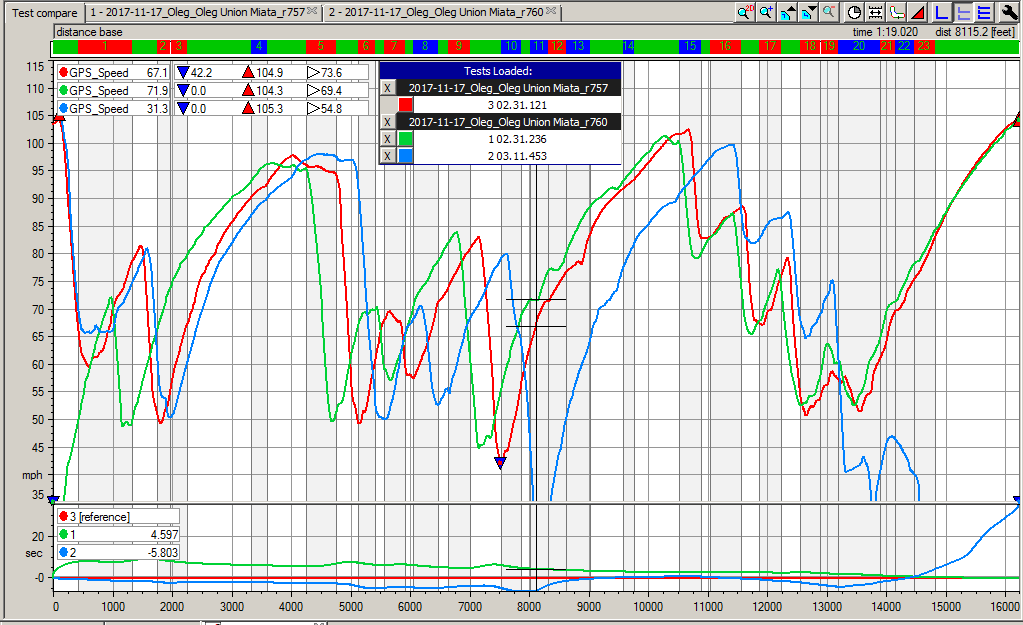
Red trace in RE-71r, blue and green are the two laps on R888R.
Despite the incomplete laps this says a lot, as we can look at the peaks and the valleys to compare minimum corner speeds and maximum straightaway speeds attained on both tires ignoring the left to right shifts in the graphs. And, in case of RE-71r and R888R, they are pretty close. Bridgestones come out ahead slightly on the back straight but R888R would have caught up within a couple more laps. R888R are ahead in turn 5 but not by much. Everywhere else taking the best of the blue and the green line the tires are fairly equal. My guess is that with a bit more time on the R888R I could run them maybe 1/2 to 3/4 of a second faster than the Bridgestones.
Road Atlanta - Vs R888R, Star Specs + RS3
The final test of 2017 saw RE-71r face off against scrubbed in R888R as well as the Star Spec/RS3 combo at Road Atlanta. All tires were driven on the 1990 Spec Miata in the same configuration, on the same day, in back to back sessions. Conditions were dry and cool with ambient temperature in the 55-65°F range.
205/50-15 full tread R888R in green, 205/50-15 RE-71r at about 1/4 tread depth in red:
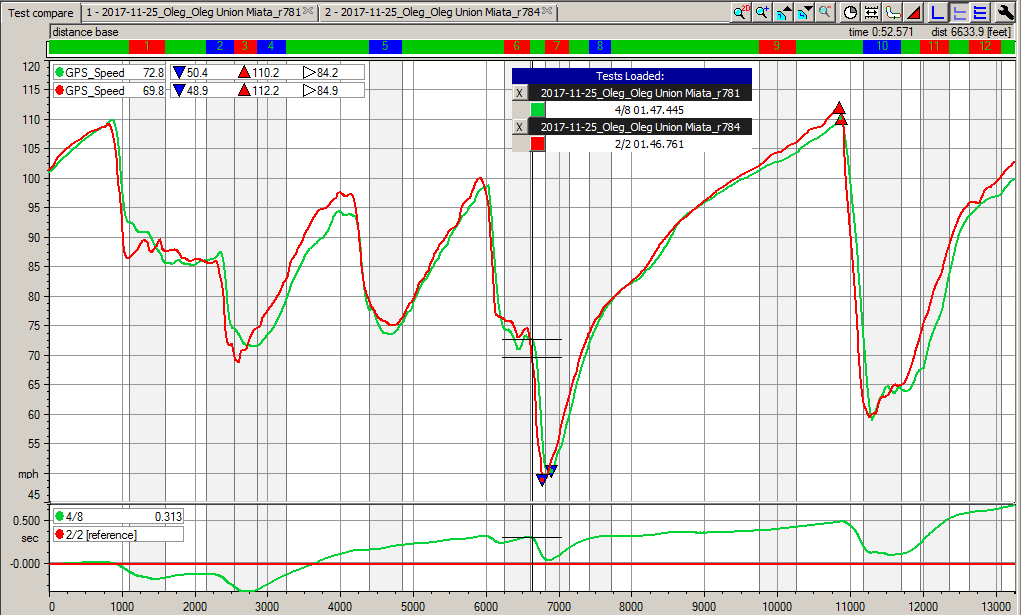
The first thing you'll notice is RE-71r are 3/4 seconds quicker than R888R. This was not for lack of trying; I drove the wheels off the car on R888R and spent about half a day on those tires to be sure I drove them to their full potential. Even so, a 200 treadwear "street" tire was able to easily outpace a 100 treadwear R compound.
The other thing that jumps out is seemingly much later throttle application on R888R vs RE-71r in turns 3 and 10, and to a lesser extent in 7. The video tells all - on the R888R lap the car was loose in turn 3 and I ran into a 911 in turn 10, thus had to lift. With those deficiencies addressed, I expect R888R to run a similar lap time to RE-71r but the fact remains that I was unable to put the car into 1:46 on R888R over 1.5 days despite my best efforts.
When I put the combo of 205/50-15 Star Specs on the front and 225/45-15 Hankook RS3 on the rear, the car became practically undrivable. It was loose coming out of most corners and slow in the corners. I've done a 1:51 on the second lap and came in after that, as there was no way for this tire combination to run a decent lap time. Arguably most of the blame belongs to the rear RS3 tires rather than the Star Spec fronts, but unfortunately I had no other street tires to put on the car for testing.
205/50-15 full tread R888R in green, 205/50-15 RE-71r at about 1/4 tread depth in red, 205/50-15 Star Specs ZII front with 225/45-15 RS3 rear in black:
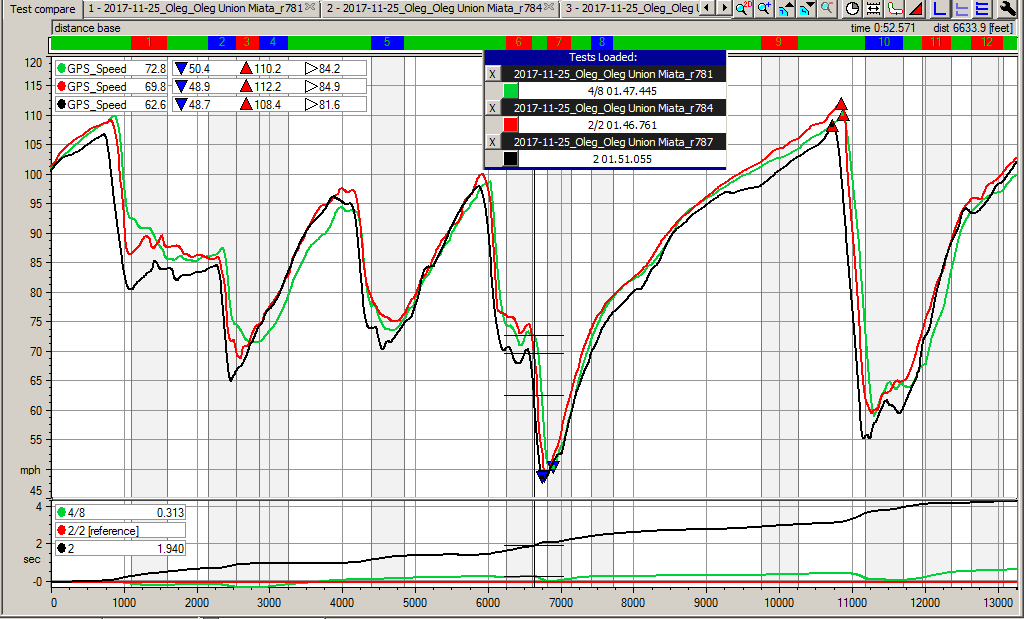
While the absolute performance of Star Specs/RS3 is quite bad, they seem to have performed surprisingly well on some of the straights, catching up to RE-71r speeds despite being significantly down on preceding corners' exit speed. This leads me to think that RE-71r may have higher drag on the straights compared to Star Specs/RS3, a feeling I have gotten in other tests sometimes.
Sebring - Vs R888R, NT01
My set of RE-71r still had some tread on them so I tested them at Sebring. The tires used in this test were stored indoors during winter and were not frozen.
The car used for this test was the 2003 Miata in the same configuration used at Summit Point in the earlier test.
- Black: 205/50-15 RE-71r (~1/5 tread remaining), 2:47.5
- Orange: 205/50-15 R888R (~3/4 tread remaining), 2:48.5
- Green: 225/45-15 NT01 (second heat cycle), 2:48.3
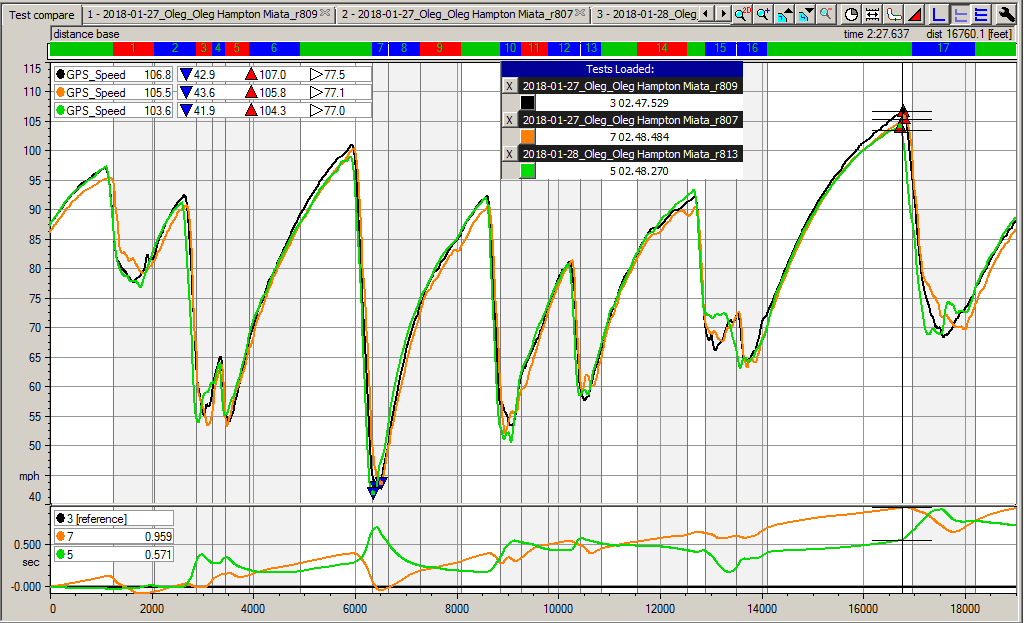
Performance overall is very similar, with RE-71r beating the hard R compound tires in lap time. RE-71r attained higher straightaway speeds, in particular putting the car at the rev limiter approaching tun 13 while the other tires did not engage the rev limiter. RE-71r offered similar but slightly worse braking performance compared to the R compounds. The car was looser on RE-71r when going into the corners, in particular going through turn 15. Response was similar between RE-71r and R compounds, with RE-71r being slightly delayed but not by much.
RE-71r were capable of almost equaling the cornering performance of the R compound tires used for comparison when RE-71r were cool, early in the session. After 20 minutes of hard laps RE-71r became greasy and the rear of the car was loose in more and more corners, at which point RE-71r were running the same pace as R compounds (in other words, RE-71r lost about 1 second/lap of speed) but with much higher wear.
As with other tracks, RE-71r wore very quickly at Sebring. I estimate that at maximum aggression level the set wouldn't last more than 4 hours of track time, and likely would not quite make it to the 3 hour mark.
Vs Spec Miata / Toyo RR
How do RE-71r compare to Toyo RR? As most of my RE-71r lap times were set with the car in the same configuration, which is close to Spec Miata1, I decided to look at 2017 results for NASA Northeast, Southeast and Great Lakes regions to compare performance of RE-71r to Toyo RR. I looked at the last two events of 2017 at the specified track and took the fastest SM lap times from each event.
| Track | RE-71r | SM/RR Best | SM/RR Second Best |
|---|---|---|---|
| Mid-Ohio (2.4 mi - Club Course) | 1:49.0 | 1:45.0 | 1:45.5 |
| NCM (3.15 mi - Grand) | 2:31.1 | 2:26.6 | 2:27.2 |
| NJMP Thunderbolt (2.25 mi - No Chicane) | 1:38.5 | 1:35.9 | 1:36.6 |
| Road Atlanta | 1:46.8 | 1:46.4 | 1:47.8 |
These comparisons were not done on the same day, and Spec Miatas generally draft whereas in my testing I did not. My biggest takeaway is that RE-71r could be a good TTE tire at Road Atlanta, whereas at other tracks Toyo RR appears to be superior in terms of performance to PT/TT points taken. I would run Toyo RR at Summit Point also; Summit Point is not in the above table because I drove a different car there.
Conclusions
The tests confirmed something I have been reading about on Spec Miata forums recently - which tire is faster at a particular track can depend on the surface of the track more than it does on the tire. Mid-Ohio seems to favor old tires, and it seems that Summit Point does as well even after the repave which was surprising. Thunderbolt likes new tires, as does NCM and most definitely Road Atlanta.
The closest competitor to RE-71r in terms of performance, of the tires I've tested, was Toyo R888R.
-
My Miata is a bit lighter than required SM weight (up to 50 lbs), but I don't run on an empty fuel tank and I do not have an aftermarket intake as allowed for NA6 SM. I do have Fat Cat bump stops, the car is pretty low, front camber is maxed out though rear camber is not. ↩
Tagged: data analysis
 Visit our
Visit our